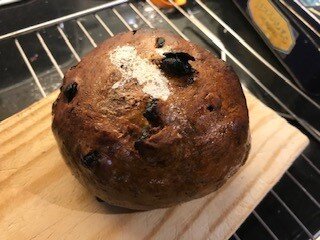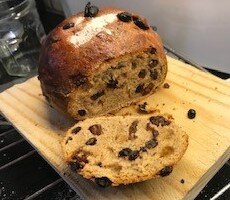WOW that’s a big cake. Elaine Foster with the programme makers and staff at Penhurst Place, Tonbrige, Kent, England
THE TEAM THROUGH THE TIN
Katy, Adam, Elaine, Orsi, Tom and John is taking the photo.
WHERE would you buy such a large cake tin? We improvised. It’s a cutting from some “big building air conditioning duct” made for us by a firm in Sheffield.
From the oven brush with sugar and rosewater glaze
This cake takes a full day or overnight to make. Don’t cut corners if you want it authentic.
NUTRITIONAL VALUES (per 100g)
Energy 1324 kJ, 315 kCal
Protein 8.1 g
Carbohydrate 55.6 g
of which sugars 13.6 g
Total Fat 6.7 g
of which Saturated 4.1 g
Salt 0.16 g
Sodium 60 mg
Fibre 2.5 g
Nutritional values are always approximate as natural ingredients vary from crop to crop.
ALLERGENS (for our recipe) Wheat, Gluten, Milk, Barley (in the ale) Check out all your ingredients if anyone has an allergy.
our SERVING SUGGESTIONS
Tudor Twelfth Night Cake is NOT a moist modern fruit cake. The texture is nearer to a scone than a moist fruit cake.
. . . so treat each slice like a scone (brilliant)
Spread with butter and a nog of your favourite cheese and chutney.
Serve with jam and clotted cream in whatever order you like.
Spread a slice with a little butter, sprinkle with grated cheese, add a dash of Hendersons relish (or Worcestershire sauce) and toast under the grill ‘till the cheese bubbles. (serve warm)
Polly Nuttall’s Tudor Cake
Tudor Cake
Our bakers made the giant cake featured in the BBC2 TV programme “A Merry Tudor Christmas with Lucy Worsley” with Lucy and author Dr Annie Gray. Directed by Peter Sweasey (THE MAESTRO)
The 4 foot diameter cake weighed 55 Kilos ( 120 lbs ) and took 2 days to make including 6 hours to bake.
It was made, by Elaine Foster and her technical team, to an original Tudor recipe translated from Old-English by our boss, John Foster MBE. (John and Elaine Foster met at Manchester baking school in 1978 and they have been baking together ever since)
We don’t sell Tudor cakes; this is our Christmas present to home bakers and food history buffs everywhere. If you fancy baking (a smaller version) of the cake yourself; here is the recipe; as translated.
The POSSET (make first)
160 g Milk
160 g Brown Ale (we used Newcastle Brown Ale)
24 g Butter
2 g Sugar
24 g Yeast (dried or fresh)
Heat all the ingredients (except the yeast) together in a pan, stirring with a wooden spoon, until the sugar has dissolved and the butter has melted.
Allow the mixture to cool until lukewarm (about 27°c)
Whilst the posset is cooling prepare your tins and the other ingredients.
When it’s luke warm, stir in the yeast until it disperses through the posset.
The CAKE
Makes 1.370 kilos (3lb of cake batter, enough for a large cake or 3 small cakes)
707 g White Plain Flour
226 g Currants
3.5 g Cinnamon
3.5 g Powdered Ginger
1.5 g Grated Nutmeg
1 g Clove or Mace*
57 g Salted Butter
370 g Posset (recipe above)
*The recipe calls for “tuppence worth” of clove or mace. I guess that means “as much as you like”; It’s probably where the phrase “sticking your two penneth in” comes from.
Our advice is to be sparing - a tiny bit on the end of a teaspoon is enough; our first attempt knocked your socks off with clove flavour.
The METHOD
Rub the Butter into the Flour and Spices (all the powders) until clear of large lumps.
Add the Posset and mix it in to a rough batter (not smooth)
Add the Currants and continue to mix until it is smooth (a couple of minutes)
Don’t knead it like a bread dough - it’s a cross between a scone dough and a bread dough.
Cover your bowl with a slightly damp cloth## and leave it for an hour.
Knock back the risen dough by mixing it for about 30 seconds (by hand).
Cover the bowl again and leave it for about 12 (yes - twelve) hours at room temperature.
Divide the dough into well greased and parchment lined baking tins.
Leave to rise (prove) for about an hour at room temperature.
Bake as you would for a fruit cake in your oven.**
Test with a skewer in the centre of the cake; it should be dry not sticky.
Whilst still warm from the oven brush the cake with a warm sugar and rosewater glaze.
If you don’t have rosewater you can use a warmed up sugar water syrup - as much sugar as the warm water will take.
** We baked our giant cake for 7 hours at 140°c BUT DON’T TRY THIS AT HOME
For our test bakes we made a cake about 30 cm (1 foot) square and baked in a cool oven (160°c, 320°f, Gas 3) for 2 hours. We also put a metal dish of water in the oven with the cake to stop the cake drying out too much.
## Yes, we know some TV chefs do it but DO NOT cover your rising dough with cling film . . for historic, technical, environmental and social reasons:
1/ They didn’t have cling film in Tudor times !
2/ The chemistry of fermentation proves that a cloth is better than cling film. (because cloth allows more available oxygen into the fermentation, cling film starves it)
3/ It’s a dumb misuse of disposable plastic that harms the environment.
4/ By telling others about these facts you will appear more intelligent on baking matters, giving you a smug sense of satisfaction.
Do visit Penhurst Place in Kent England, where the banquet took place. A beautiful Tudor manor house with delightful gardens. CLICK HERE for their website.
A big thanks to the film crew and staff at Penhurst Place, Kent for helping us manoeuvre the mammoth cake into the banqueting hall safely and in one piece - phew!
BAKING TIP
HOME BAKER Polly Nuttall offers this information.
I made 1/4 of the recipe as a test and cooked it for half an hour at 180°c.
Then I looked at it for about 5 minutes, realised it wasn’t cooked and put it back into a HOT oven for 15 minutes which is what I believe the Tudor bakers would have done at Hampton Court...
It’s delicious, especially when you adjust to its savoury nature.
The posset smelt amazing, and made me wonder if that’s where Harry Potter’s butter beer comes from.
Many thanks for putting this recipe online and cheering up a rainy morning.
Best wishes
Polly






